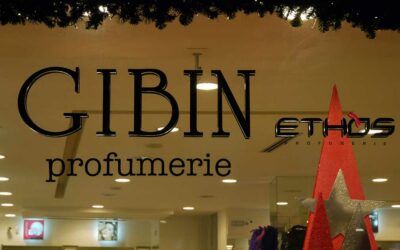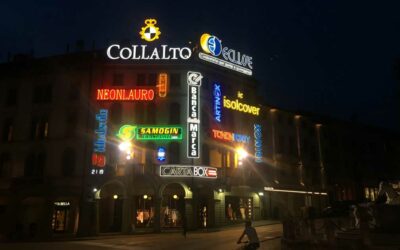13 January 2025

Index:
- The Importance of an Accurate On-Site Inspection
• Structural assessment
• Optimal placement
• Compliance with regulatory requirements
• Analysis of environmental conditions- Technical Consultation: The Foundation for Customized Design
• Analysis of client needs
• Tailor-made design
• Technical optimization
• Project approval- Innovations and Trends in Illuminated Signs
- Why Choose NeonLauro
- Conclusions
- The Importance of an Accurate On-Site Inspection
The on-site inspection is the starting point for any illuminated sign installation project. It is a crucial step that allows the collection of all necessary information to ensure an excellent outcome.Structural Assessment
Structural evaluation is the first fundamental step in the installation process of an illuminated sign. Every building and area has specific characteristics that influence feasibility and the type of intervention required. During this phase, NeonLauro’s technicians thoroughly analyze various technical and structural aspects:
- Surface Stability: Walls or supports where the sign will be installed are examined to ensure they can bear the weight and withstand stresses like wind or vibrations. If necessary, alternative solutions, such as adding reinforcements or using self-supporting structures, are proposed.
- Material Type: The base structure, whether concrete, metal, wood, or glass, affects the choice of fastenings and materials. For instance, a sign installed on a historic facade may require non-invasive techniques to preserve architectural heritage.
- Accessibility for Installation: The installation is planned by evaluating site access and, if needed, using cranes, scaffolding, or aerial platforms to ensure safe and precise execution.
These analyses help prevent potential issues and enable tailored solutions for each context.
Optimal Placement
The positioning of an illuminated sign is crucial to maximize its effectiveness and visibility for both nearby and distant observers. NeonLauro considers several factors to determine the ideal position:
- Lines of Visibility: Experts analyze the angles from which the sign will be most visible. Good visibility requires the sign to be positioned at a strategic height and oriented toward high-traffic areas.
- Surrounding Lighting: The interaction with natural and artificial light sources is assessed. For example, a sign in a brightly lit area may require more intense lighting or colors that effectively contrast with the environment.
- Urban Context: The sign must stand out without appearing out of place. NeonLauro considers the surrounding architecture and local regulations to ensure the sign is not overly intrusive and harmonizes with the landscape.
- Dynamic Perspectives: In outdoor areas with pedestrian or vehicular traffic, the average visibility time is considered. For example, a sign visible for only a few seconds might need a shorter and more direct message.
With a detailed analysis, the sign not only captures attention but also communicates the brand message effectively.
Compliance with Regulatory Requirements
Adherence to regulatory requirements is crucial to ensure that the sign is installed in compliance with applicable laws and local regulations. NeonLauro handles all bureaucratic steps to ensure a smooth process:
- Local Regulations: Each municipality may have specific rules regarding maximum sign dimensions, usable colors, brightness levels, and minimum distances from buildings or public infrastructure.
- Safety Certifications: Every component of the sign must meet recognized safety standards, such as CE certifications or other technical compliance norms.
- Energy Efficiency: Many administrations encourage the use of low-energy technologies. NeonLauro ensures every project is designed to minimize energy consumption, helping clients benefit from potential tax incentives.
- Permits and Authorizations: The company obtains all necessary permits, including landscape authorizations for historic areas or road permits for installations in public spaces.
This approach ensures the sign fully complies with legal requirements, allowing the client to focus solely on the benefits of the final product.
Analysis of Environmental Conditions
Another essential aspect to guarantee the durability and efficiency of the sign is analyzing the environmental conditions of the installation site. NeonLauro considers every detail to ensure the sign withstands climatic and environmental challenges. For outdoor signs, the following factors are assessed:
- Sun Exposure: In particularly sunny areas, UV-resistant materials are used to prevent fading or damage over time. Additionally, solutions that limit heat buildup are adopted to protect electronic components.
- Weather Resistance: For installations in areas prone to rain, snow, or strong winds, waterproof materials and reinforced supports are chosen. In coastal areas, where salt can corrode metals, specific anti-corrosion treatments are applied.
- Light Pollution: NeonLauro designs signs that comply with light pollution regulations, avoiding unnecessary light dispersion and ensuring a pleasant visual impact.
- Interaction with Vegetation: In natural settings, the interaction with trees or other plants that might obstruct visibility or damage the sign over time is considered.
Thanks to careful environmental analysis, every sign created by NeonLauro is designed to last and maintain its communication effectiveness, even under challenging climatic conditions.
- Technical Consulting: The Foundation for Tailored Design
Technical consulting for signage is the cornerstone of every successful project, representing the essential step in turning an idea into a tangible reality. At Neonlauro, this phase stands out for its methodical and personalized approach, where every detail is carefully considered to ensure exceptional results.
Analyzing Client Needs
The process begins with a thorough analysis of the client’s needs, allowing the collection of all necessary information to develop a tailored solution. This phase is characterized by:
- In-depth discussions: Dedicated meetings with the client to fully understand their expectations, communication goals, and budget constraints.
- Target evaluation: A sign is not just a decorative element but a marketing tool; defining the intended audience is crucial.
- Brand study: The sign must reflect the company’s visual identity. Colors, shapes, and styles are selected in line with the message to be conveyed.
- Functional aspects: Practical data, such as sign operation times and material preferences, are also gathered during this stage.
Through this analysis, the Neonlauro team ensures a project that not only meets the client’s requirements but exceeds them, anticipating future needs.
Custom Design
With the collected information, the process moves to custom design, the true creative and technical phase where every detail takes shape:
- Personalized design: A graphic layout is developed that integrates aesthetics and functionality. Signs are designed to capture attention and remain memorable.
- 3D simulations: Advanced modeling software provides a realistic preview of how the sign will look once installed. This tool allows clients to visualize the final result and make real-time adjustments.
- Material selection: Based on the initial analysis, high-performance and durable materials are chosen to ensure maximum longevity.
- Technological integration: For innovative signs, features like remote control systems or interactive functions can be incorporated, making the project unique and technologically advanced.
Each project balances creativity, innovation, and practicality, ensuring the sign represents the client and their brand to the fullest.
Technical Optimization
Once the design is defined, the process moves to technical optimization, a critical phase to ensure the sign’s functionality and compliance with contextual requirements:
- Technical specifications verification: All components are tested to meet the highest quality standards.
- Adaptation to structural constraints: The sign is optimized for seamless integration, minimizing risks of incompatibility or technical issues.
- Energy efficiency: Special attention is given to energy consumption, adopting solutions that ensure savings without compromising performance.
- Resistance testing: The sign undergoes tests to ensure it withstands various stress factors, guaranteeing stability, safety, and durability over time.
This phase identifies and resolves potential issues before the sign is manufactured and installed, ensuring optimal performance.
Project Approval
The final step in technical consulting is project approval, a moment of final review with the client to ensure all aspects are addressed and expectations are met. This phase includes:
- Detailed presentation: The client receives comprehensive documentation, including technical drawings, 3D renderings, and detailed descriptions of the selected materials.
- Client feedback: Every suggestion or request for modification is carefully considered and integrated into the final project. Neonlauro strongly believes in collaboration and transparency with its clients.
- Installation planning: Once the project is approved, the installation activities are organized. The client is informed of every detail, from transportation to assembly, ensuring a smooth process.
Thanks to this approach, the client is assured of receiving a product that fully reflects their expectations, with the added guarantee of continuous support even after installation.
- Innovations and Trends in Illuminated Signs
The illuminated signage industry is constantly evolving, with increasingly advanced technologies and materials. Current trends include:
- Smart lighting: Systems that automatically adjust brightness based on ambient light, reducing energy consumption.
- Eco-friendly materials: The use of recycled glass and components free of toxic substances.
- Minimalist design: Clean lines and neutral colors for a modern and sophisticated effect.
Neonlauro is at the forefront of these innovations, offering clients solutions that blend technology, aesthetics, and environmental sustainability.
- Why Choose Neonlauro
- Experience: With nearly 70 years in business, Neonlauro is synonymous with quality and reliability.
- Comprehensive service: From consulting to maintenance, every phase is managed in-house.
- High-quality materials: Only the best components are used to ensure durability and safety.
- Post-sale support: A dedicated team is always available for maintenance or upgrades.
5. Conclusions
Choosing an illuminated sign is not just a visual investment but a strategic element that transforms the perception of your brand. Achieving the ideal result requires a meticulous approach, and Neonlauro places the client at the center of every project.
Each project begins with an open dialogue, where qualified experts listen to the client’s needs and translate them into concrete, innovative solutions. Whether it’s creating a modern sign or restoring a vintage one, Neonlauro pays the utmost attention to detail, staying at the forefront of technologies and trends. This approach enhances the client’s image while contributing to environmental sustainability.
The process of on-site inspection and technical consulting is more than just a service; it’s a guarantee of quality from start to finish, with post-sale support ready to address any needs. Contact our team today to discover how we can turn your vision into reality and make your project a new visual landmark.
Related articles
Decorations: Creativity and Innovation for Every Occasion
Decorations are much more than simple aesthetic elements: they are powerful tools for communicating identity, emotions, and values. Whether it’s a store, a special event, or a workplace, these innovative solutions …
Our story: How Neonlauro brought the art of neon to Italy
Tradition, innovation, and quality in Neon Signs In the world of illiminated signs, few names resonate with the same authority and reliability as Neonlauro. Founded over half a century ago …
Our commitment to handling authorization processes: Less bureaucracy, more time for you
Managing authorization processes is often one of the most complex and time-consuming challenges. Long timelines, constantly changing …




